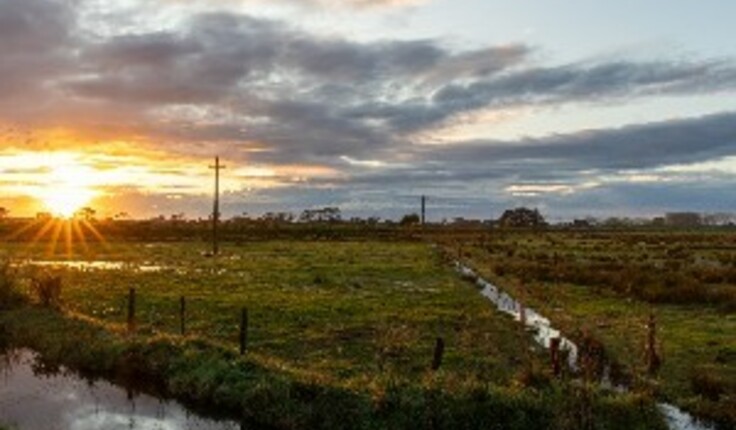News
30 Hectare Wetland is Being Restored to Support the Health of the Waihī Estuary
Posted 11 12 2023
in News

Whānau of Ngāti Whakahemo at Pukehina marae, undertaking a kaupapa Māori project to understand the needs of the Waihī estuary, leveraged $125,000 of Our Land and Water funding into $7 million.
In partnership with Bay of Plenty Regional Council and mana whenua groups, those funds have been used to undertake a significant multiyear restoration programme, including the purchase of 30 hectares at the edge of the estuary to restore wetland ecosystems. This is anticipated to protect and improve the mauri of the estuary, a key objective for Our Land and Water, and provides an exemplar for hapū around the motu.
This project was funded by Our Land and Water to extend the Healthy Estuaries research programme, a partnership with the Sustainable Seas National Science Challenge. The overarching programme responds to an unintended gap created through the separation of land- and sea-based issues in the National Science Challenge structure. It aims to assess cumulative impacts of land use and freshwater contaminants on estuarine environments and to identify the contaminant thresholds required to restore their ecological function. The programme includes three case study estuaries.
Tāwharautia te Wahapū o Waihī was developed to explore a different approach in one of those case studies. Led by Professor Kura Paul-Burke (University of Waikato), whānau of Ngāti Whakahemo sought to understand the history of the estuary and its experiences over time through kōrero tuku iho (oral histories and traditions), and through developing closer relationships with the estuary via monitoring and observation. This enabled Ngāti Whakahemo to help the estuary have its own voice, and a means to determine what it needs to be well again.
The Waihī estuary is severely degraded with permanent health warnings for collection of shellfish and declining populations of shellfish, seagrass meadows, bird species, and fish species. Nana (seagrass), one of the most important health indicators of the estuary, has reduced from 80 hectares in 1943 to less than one hectare today.
With a relatively small total catchment area (approximately 35,000 hectares) the ability to affect change through collective action is high. However, there are serious challenges to overcome. At the outset of the project, the four main tributaries emptying into the estuary were straightened canals., with no buffers or contaminant filtration mechanisms.
Our Land and Water funding provided Ngāti Whakahemo and Pukehina Marae with resources to build their internal capacity to support the voice of the estuary. The project also initiated collaborative fieldwork by Ngāti Whakahemo with NIWA and the University of Waikato, resulting in rapid habitat assessment maps and temperature loggers to better understand the impact of climate change on the estuary and mahinga kai.
A key finding of the research was the importance of mātauranga Māori and marine science working together to provide evidence-based information on the current state of the nana (seagrass), tuangi (cockles) and tōrea (oyster catcher birds) in the estuary.
With increased capacity to understand the estuary, Ngāti Whakahemo gained confidence to directly engage others on opportunities to support restoration action. This led to the collectivisation of Ngāti Whakahemo with four other iwi partners who also border the estuary (Ngāti Whakaue ki Maketū, Ngāti Pikiao, Ngāti Mākino, and Tapuika), marking the first time that all five iwi have banded together to advance the cause of the estuary.
The iwi collective, with support from Bay of Plenty Regional Council, were successful in securing funding from Ministry for the Environment’s Freshwater Improvement Fund for a four-year restoration programme, Te Wahapū o Waihī.
Together, the iwi collective and Bay of Plenty Regional Council have purchased 30 hectares of land adjacent to the estuary to re-establish a wetland/saltmarsh, providing much-needed filtration between the estuary and the catchment canals. The research team is considering an invitation to work with The Nature Conservancy and Terra Carbon to establish carbon monitoring once it is constructed.
Te Wahapū o Waihī will also work with local farmers and provide support to assist with Farm Environment Plans. Local community groups, regional and central agencies have also indicated interest in engaging with the kaupapa.
Our Land and Water’s commitment to te ao Māori has motivated it to think differently about how it connects to, resources, and supports kaupapa Māori research, making it a unique funding partner. Whānau, hapū, and marae-based research is quick to gain momentum and demonstrate excellence when strong Māori leadership with science sector experience is in place. The research team were confident the kaupapa would draw restorative investment from communities, government and industry, which proved correct.
This article was originally submitted to MBIE as an impact case study as part of Our Land and Water's 2022–23 annual reporting. It is shard under Creative Commons Attribution 4.0 International (CC BY 4.0)
More information:
Healthy Estuaries research
Transformational joint venture to restore Waihī Estuary (Bay of Plenty Regional Council)
14 Apr
NZILA Board nominations close tonight

Read the insights from current Board members
What does the current Board have to say about this opportunity? REMINDER: Board Nominations close tonight, 14 April, 11.59pm We …
08 Apr
Update from Environmental Legislation Working Group
RMA Reforms and NZILA Wānanga
Our understanding of Spatial Planning and in creating well-functioning environments is more deeply considered than simply green fluff - the …
02 Apr
Follow up from the virtual IFLA World Council (22 and 23 March)

Did you attend the virtual IFLA World Council held last weekend? Presentations and ReportsThese can be found here. RecordingFor those …
Events calendar
Full 2025 calendar